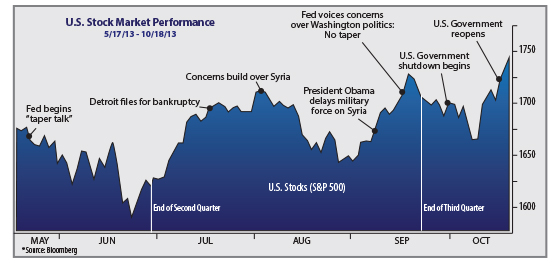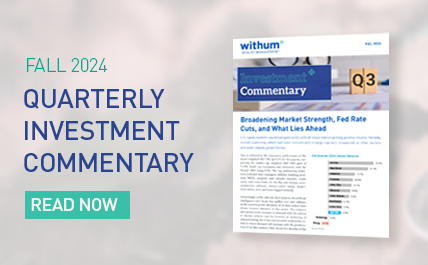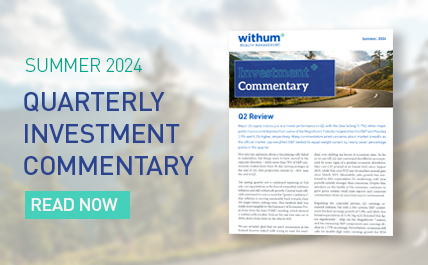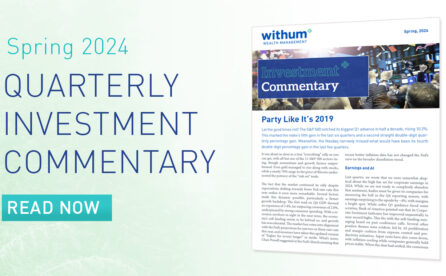Third Quarter in Review
Equities powered through several headwinds this quarter providing an important lesson on the benefits of maintaining a disciplined investment approach during periods of market volatility. Despite concerns surrounding the upcoming Federal Reserve tapering, a conflict in Syria that almost lead to another war, the largest U.S. municipal bankruptcy in history, and a threatening government shutdown over budget negotiations, the S&P 500 index increased 5.2% for the quarter (see U.S. Stock Market Performance chart). Playing catch-up for the year, the international markets fared better, with the FTSE All World ex US gaining 10.1% over the same period.
Volatility in the bond markets was also observed as the yield on the benchmark 10-year Treasury note rose to almost 3.0% only to fall to 2.6% after the Federal Reserve surprised the market by deciding not to taper at its September meeting.
U.S Economy: To Taper or Not to Taper
After Federal Reserve Chairman Ben Bernanke mentioned tapering in his May speech, the conversation shifted from “if tapering would happen” to “when will tapering happen”. A report by ISI Group indicated that over 70% of investors surveyed anticipated an announcement of a reduction in the amount of bond buying by the Federal Reserve at their September meeting. To the surprise of many economists and investors on Wall Street, the Federal Reserve indicated they would not begin the tapering process just yet. At the press conference following the meeting, Bernanke stated that while economic conditions are improving, downside risks remain. He noted the potential for contentious debt ceiling and federal budget discussions in Congress to negatively impact the economy. Moreover, he highlighted the importance of assessing the potential negative impacts that tighter financial conditions, chiefly mortgage rates, would have on the housing market and to the real economy before any reduction in bond purchases takes place.
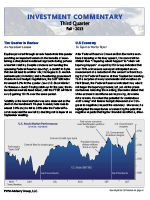 |
Download the Investment Outlook PDF >>
|
As mentioned above, rising mortgage rates may present a possible threat to the housing recovery. The average rate for a 30-year fixed mortgage is 4.58% according to mortgage lender Freddie Mac. While this rate represents a two-year high, it is still not high enough to materially undermine demand. Housing remains very affordable at the current level of borrowing costs and home prices (see Home Affordability Composite Index chart). Home prices are up 10.8% in the last 12 months according to the S&P/Case-Shiller index– if this trend continues, the resulting positive wealth effect could create even greater demand for housing and consumption.
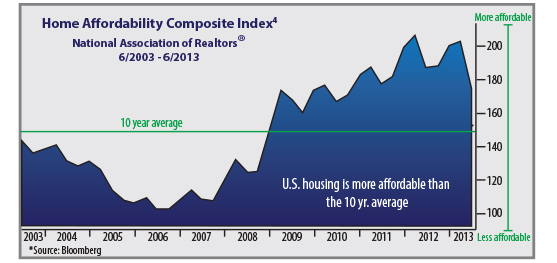
The latest unemployment numbers were also attributed for the Federal Reserve’s decision not to start tapering. The unemployment rate dropped to 7.3%, its lowest level in roughly five years, but the reduction was mainly due to people leaving the labor force (see Labor Participation Rate chart). According to the most recent unemployment report, 169,000 new jobs were created in August, slightly below expectations. More important, however, was the revision of the July numbers down 74,000 jobs, further evidence that the employment picture is not where it needs to be.
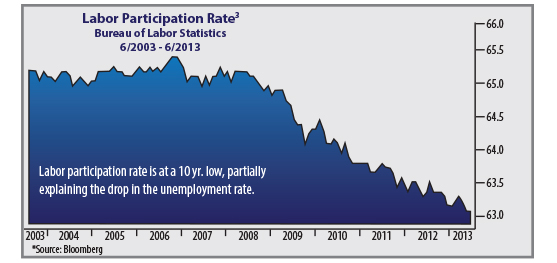
On a more positive note, the final reading for second quarter real Gross Domestic Product (GDP) increased at an annualized rate of 2.5%, a significant increase from the 1.1% annualized rate recorded in the first quarter. The increase in real GDP in the second quarter primarily reflected positive contributions from exports, private inventory investment and residential and non-residential fixed investment.
International: Developed Markets Take the Lead
Developed international countries continue to surprise the market. Positive economic and manufacturing data out of Europe continues, which supports the possibility that the worst may have past. On the political arena, German Chancellor Angela Merkel was reelected for a third term ensuring a continuation of current policies and suggesting further support for Euro area reform. In Japan, Prime Minister Shinzo Abe continues to live up to his promise to do whatever it takes to support the economy. In an effort to trim Japan’s massive debt burden, Prime Minister Abe has committed to a tax hike that will also incorporate a string of measures—including further spending on infrastructure and investment incentives for corporations—to prevent any unintended downward pressures on the economy. We are encouraged by these advancements, which are also supported by attractive valuations relative to domestic equities, and believe investors can benefit from a stable and growing Europe and Asia.
Emerging markets remain mixed. In general, concerns about the removal of excess liquidity by the U.S. Federal Reserve affected currencies, equities and emerging market debt alike. The delay to Fed tapering seemed to give these countries a short term reprieve, but the eventual start to the tapering process could pressure future economic growth. Moreover, structural headwinds such as high inflation, export and commodity dependence, and fiscal mismanagement afflict many of the countries in the emerging market universe. These structural imbalances, which could take several years to resolve, need to be addressed in order to achieve more sustainable growth rates over time. While the near term looks uncertain, we believe that emerging market exposure is important for the long-term investor.
A Look Ahead: The Political Drama Returns
While we still have several hurdles, including the debt ceiling debate, a government shutdown, and Fed tapering, the US economic recovery is gradually solidifying and broadening. It is important to remember that “tapering” does not mean “tightening”. The Federal Reserve balance sheet should continue to expand into 2014, keeping liquidity conditions and monetary policy reflationary. The rest of the world has also seen its prospects brighten slowly as Europe appears to have bottomed out, Japan continues to show promise, and China seems to be stabilizing. The global growth picture is improving gradually aided by these developments.
The US debt ceiling debate is shaping up to be the most contentious yet with Republicans and Democrats nowhere near agreement on the overall amount of the fiscal 2014 budget and deep divisions over the Affordable Care Act. The ramifications of failing to raise the debt ceiling, whether it is before the October 17th deadline or a deadline set for early 2014, are serious and could have a negative effect on the financial markets. The bitter partisan divide on Capitol Hill means that a Grand Bargain that both raises the debt ceiling and incorporates a long term budget deal remains a distant possibility.
The unexpected nature of the September Fed announcement will likely increase investor confusion about its plans to gradually decrease the monetary stimulus. As investors try to establish a base case for the timing and magnitude of the taper in the coming months, volatility in the markets could increase. In addition, other sources of potential near term volatility include the market’s reaction to any government economic data that has yet to be released because of the government shutdown.
While Washington politics are a concern, we believe equities, both here and abroad, still trade at reasonable valuations and provide a long term attractive risk reward proposition. As the global economy gradually improves and the monetary environment remains reflationary, equities should fare well. In addition to the Federal Reserve, major central banks around the world are maintaining their accommodative stances to support the economic recovery. We are positioning portfolios to benefit from what we believe to be a net positive global economy.
This quarterly letter was brought to you by the financial advisors at PWM Advisory Group – Private Wealth Management
GLOSSARY
1. Taper
The term used by Federal Reserve Chairman Ben Bernanke to explain how the Federal Reserve will gradually reduce its $85 billion a month bond purchasing program (quantitative easing).
2. Debt Ceiling*
[Also known as the “debt limit” or “statutory debt limit.”] The maximum amount of monies the United States can borrow. The debt ceiling was created under the Second Liberty Bond Act of 1917, putting a “ceiling” on the amount of bonds the United States can issue. As of the end of September, 2013 the debt ceiling was set at $16.7 trillion**. Over time, the debt ceiling has been raised whenever the United States comes close to hitting the limit. By hitting the limit and missing an interest payment to bondholders, the United States would be in default, lowering its credit rating and increasing the cost of its debt.
3. Home Affordability Composite Index
An index by the National Association of Realtor® that tracks the affordability of housing typically based on a mix of median home prices, median income, and mortgage rates****. A value of 100 means that a family with the median income has exactly enough income to qualify for a mortgage on a median-priced home. An index above 100 signifies that family earning the median income has more than enough income to qualify for a mortgage loan on a median-priced home, assuming a 20 percent down payment***.
4. Labor Participation Rate*
An index by the Bureau of Labor Statistics that measures the active portion of an economy’s labor force. The participation rate refers to the number of people who are either employed or are actively looking for work. The number of people who are no longer actively searching for work would not be included in the participation rate.
5. Gross Domestic Product (GDP)*
The monetary value of all the finished goods and services produced within a country’s borders in a specific time period (usually calculated on an annual basis). GDP is commonly used as an indicator of the economic health of a country, as well as to gauge a country’s standard of living. A rising GDP is generally a positive sign for the economy.
6. Reflation*
An economic or monetary policy, designed to expand a country’s production and curb the negative effects of deflation. Reflation policies can include reducing taxes, changing the money supply and lowering interest rates. Reflation is generally a net positive for the economy.
7. Partisan Divide
A term used to describe contrasting views of political parties. These contrasting views have a tendency to negatively affect negotiations. For example, Democrats are generally in favor of the “Affordable Health Care Act” while Republicans generally oppose it. This divide is preventing Republicans and Democrats from having successful budget negotiations.
Definitions from *investopedia.com, **Pew Research Center, ***National Association of Realtors®, ****Bloomberg Professional
Please remember that past performance may not be indicative of future results. Different types of investments involve varying degrees of risk, and there can be no assurance that the future performance of any specific investment, investment strategy, or product (including the investments and/or investment strategies recommended or undertaken by PWM Advisory Group, LLC. [“PWM”] ), or any non-investment related content, made reference to directly or indirectly in this newsletter will be profitable, equal any corresponding indicated historical performance level(s), be suitable for your portfolio or individual situation, or prove successful. Due to various factors, including changing market conditions and/or applicable laws, the content may no longer be reflective of current opinions or positions. Moreover, you should not assume that any discussion or information contained in this newsletter serves as the receipt of, or as a substitute for, personalized investment advice from PWM. Please remember to contact PWM in writing, if there are any changes in your personal/financial situation or investment objectives for the purpose of reviewing/evaluating/revising our previous recommendations and/or services. PWM is neither a law firm nor a certified public accounting firm and no portion of the newsletter content should be construed as legal or accounting advice. A copy of the PWM current written disclosure statement discussing our advisory services and fees is available for review upon request. Photo Credit: RubenPS
If You Liked This Article, SHARE IT!
Help Us Spread The Word. Share This Article With Your Friends & Peers

